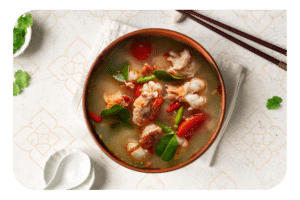The world is more connected than ever, allowing consumers to travel and experience traditional cultures in different countries. As our Biospringe Asia Pacific team is based in Singapore, we are close to the market, and we observed trends shifts and acceleration over the past years. Interestingly, we discovered the emerging regional taste trend. Consumers are seeking authentic yet accessible region-specific cuisines. We responded swiftly by collaborating internally with the Culinary Center technical team to create “Taste series”, meaning to say we explored the key local taste profiles across Asia to identify the most popular ones. Then, we develop solutions to support food manufacturers in their taste challenges.
Different taste profiles across Asia Pacific
As the most inhabited region of the world, Asia has also the most diverse cuisines worldwide. Even if some ingredients cross borders, for example rice, soybeans or noodles, the cooking techniques and flavors vary differently from cuisine to cuisine. From one country to the other, one foodstuff can be appreciated uniquely and possess different flavor profiles. Moreover, while some cuisines will taste spicy such as the Indian one, others will be more umami like the Japanese one, and some more flavorful like Thai. From Sichuan-style crispy pork belly to miso soup, Indian curry and Thai coconut ice cream, the dishes are as diverse as the countries.
In 2023, Japanese, Indian, Thai and Chinese cuisines are among the 10 most popular ones worldwide. This reflects that those cuisines all have various flavor profiles able to satisfy everyone.
Knowing that we cannot simply speak about “Asian cuisine” because of all the different flavor profiles across Asia, our experts decided to focus on top trends cuisines across Asia, first with a Japanese Taste Series, and now with a Thai one. Our Food Technologist Ming Pei Yeo explains : “In alignment with market expectations, we create regional taste series based on key innovative concepts to bring taste solutions in local representative cuisines. This is to provide taste inspirations to our customers.”

Our first taste series: Experiencing Japanese Taste
All around Asia Pacific, Japanese cuisines are well appreciated and mostly enjoyed for their delicate taste and appearance. Indeed, Japanese foods are often consumer’s “second choice” coming after local cuisines. Yeast extract, which is a natural ingredient, can help to bring many taste benefits. For example, in a Japanese Tonkotsu recipe, yeast extract helps to highlight the pork meaty profile, brings natural umami notes, and intensifies richness with a long-lasting savory sensation. As our main concern is always to answer to our customers’ needs and expectations, we asked to our partner in Japan his feedback on our Japanese Taste Serie: “It is amazing to see how yeast extract can bring that many benefits in all segments (savoury and sweet applications) to improve taste and provide an authentic Japanese style recipe.”

Thai Taste Series
Thailand cuisine is part of Thailand’s special traditional culture. For this reason, it has become a familiar destination to people from all over the world. Thai cuisines are all about blending a plethora of fresh ingredients to create a harmonious finish, particularly ingredients like lemongrass, galangal, chili and coconut milk. Most of the time, Thai dishes deliver explosion of exotic flavors and pleasant fragrances at every mouthful with a mix of sour, spicy, salty, sweet, and sometimes bitter taste for a satisfying taste experience. As a matter of fact, yeast extract can perform equally well in sweet applications such as the local desserts like the Thai coconut ice cream. It boosts up the original coconut flavor, increases coconut sweetness intensity, and improves the creaminess and richness profile.
Through five representative recipes, our experts demonstrated the benefits of yeast extract in Thai cuisine.

Experiencing Korean Taste
“K-food” was originally one small movement of Korean Wave which is called in Korean, ‘Hallyu’. The term came from the Korean popular culture built with K-drama and K-pop since early 2000s, and now has a great influence on beauty, fashion, food and beverages.
Hallyu first spread to China and Japan, later to Southeast Asia and several countries worldwide where it continues to have a strong impact. Fuelled by the popularity of Korean pop music and television shows, Korean food is on-trend among Asian consumers, spurring new product development and e-commerce platforms specialised in K-foods.
In this leaflet composed of seven recipes, our Biospringer experts demonstrate the benefits of yeast extract in Korean cuisine.

Experience Indian Taste in Snacks
The Indian food market is evolving with a focus on health, regional diversity, and convenience. Consumers are choosing healthier, natural ingredients and exploring diverse regional cuisines. Premium and artisanal products are gaining popularity, alongside a rising demand for plant-based and vegan options. Global cuisines are influencing culinary trends, promoting innovation and authenticity in traditional Indian flavors.
Biospringer has anticipated and rode on this trend, presenting to you the top Indian taste inspirations with Biospringer range of yeast extracts.









